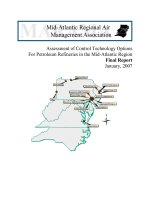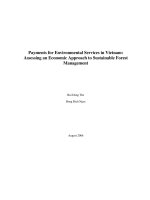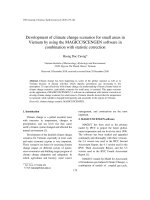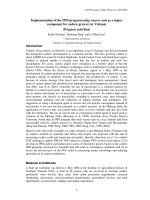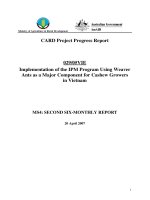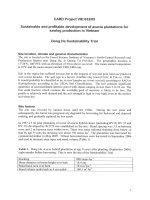Exploring call options for teaching EFL in Vietnam
Bạn đang xem bản rút gọn của tài liệu. Xem và tải ngay bản đầy đủ của tài liệu tại đây (1.02 MB, 118 trang )
Minnesota State University, Mankato
Cornerstone: A Collection of
Scholarly and Creative Works for
Minnesota State University,
Mankato
eses, Dissertations, and Other Capstone Projects
2011
Exploring CALL Options for Teaching EFL in
Vietnam
Nhon anh Dang
Minnesota State University - Mankato
Follow this and additional works at: hp://cornerstone.lib.mnsu.edu/etds
Part of the Bilingual, Multilingual, and Multicultural Education Commons
is APP is brought to you for free and open access by Cornerstone: A Collection of Scholarly and Creative Works for Minnesota State University,
Mankato. It has been accepted for inclusion in eses, Dissertations, and Other Capstone Projects by an authorized administrator of Cornerstone: A
Collection of Scholarly and Creative Works for Minnesota State University, Mankato.
Recommended Citation
Dang, Nhon anh, "Exploring CALL Options for Teaching EFL in Vietnam" (2011). eses, Dissertations, and Other Capstone
Projects. Paper 273.
Exploring CALL Options for Teaching EFL in Vietnam
By
Nhon Thanh Dang
An Alternate Plan Paper Submitted
In Partial Fulfillment of the Requirements for the Degree
Master of Arts
In
Teaching English as a Second Language (TESL)
Minnesota State University, Mankato
Mankato, Minnesota
May 2011
Date: March 29
th
, 2011
This Alternate Paper Plan has been examined and approved.
Examining Committee:
_____________________________________________
Dr. ESTHER SMIDT, Committee Chair,
Department of English
______________________________________________
Prof. & Dr. STEPHEN STOYNOFF, Committee Member
Department of English
TABLE OF CONTENTS
Chapter I. INTRODUCTION……………………………………………………. …… 1
Context, General Problem, and Purpose…………………………………….…… 1
Definitions of Terms…………………………………………………………… 5
Organization………………………………………………………………… …. 7
Chapter II. LITERATURE REVIEW……………………………………………………. 9
Introduction…………………………………………………………………… 9
Uses of CALL Tools in ESL Education in Developed Countries………………. 11
Language Areas and Technological Options…………………………….12
Vocabulary……………………………………………………….12
Grammar…………………………………………………………14
Pronunciation…………………………………………………… 15
Language Skills and Technological Options……………………………. 18
Writing……………………………………………………… … 18
Reading…………………………………………………….…… 21
Listening…………………………………………………… 24
Speaking……………………………………………… ………. 26
Uses of CALL Tools in Teaching ESL/EFL in Asian Developing Countries… 29
Taiwan…………………………………………………………… …… 30
China…………….………………………………………………… …. .32
Malaysia………………………………………………………….………34
Thailand…………………………………………………………….……35
Prevalence of Using CALL in Teaching EFL in Vietnam……………….………36
Implications for Integrating CALL Tools in ESL/EFL Instruction………… … 39
Chapter III. EXPLORATIONS OF CALL OPTIONS FOR TEACHING EFL IN
VIETNAM……………………………………………………………………………… 42
Context and Factors Affecting CALL Applications in Vietnam…………… …. 42
Technology Standards and Criteria for CALL Option Selection…………… … 46
Technology Standards and Desirably Applied Context…………… … 46
Criteria for CALL Option Selection…………………………… …… 47
Criteria for selecting websites or materials available online…… 48
Criteria for selecting authoring software programs………… … 49
CALL Training for Teachers and Students……………………………….…… 50
Suggested CALL Options for Teaching EFL in Vietnam………………….…… 54
Options for teaching Language Areas………………………….….….… 55
CALL options for instructing grammar………………………… 55
Authoring tools………………………………… … …. 56
Dedicated websites………………………….…… …… 60
CALL options for vocabulary instruction…………….… ….… 62
Authoring tools……………………………….… …… 62
Dedicated websites……………………….……… …… 64
CALL options for teaching pronunciation……………….….…. 66
Software programs…………………………….….… … 67
Dedicated websites…………………………….…….…. 68
CALL Options for Teaching Language Skills…………………….……. 71
Options for teaching writing skills…………………….… ….….71
Authoring tools…………………………………………. 72
Dedicated websites…………………………….….……. 77
Options for teaching reading skills…………… ………………. 78
Authoring tools…………………………… …….…… 79
Dedicated websites……………………………….…… 80
Options for teaching listening skills………………………… 82
Authoring tools…………………………………… … 82
Dedicated websites………………………….… ……… 84
Options for teaching speaking skills………………………….… 86
Authoring tools………………………………… ….… 87
Summary…………………………………………………………………………91
Chapter IV. CONCLUSION……………………………………………… ……….… 92
REFERENCES……………………………………………………………… ……… 97
FIGURES
Figure 1. Half-Baked Software's Hot Potatoes: The multiple-choice template of JQuiz
can core correct answer and provide feedback…………………………….…… 57
Figure 2. The Free Dictionary has audio and phonetic symbols and vocabulary games
(Hangman and Spelling Bee) that motivate the way learners learn vocabulary…65
Figure 3. Phonetics: the Sounds of Spoken American English developed by the
University of Iowa……………………………………………………………… 69
Figure 4. Blogger facilitates writing as journal pr diary entries…………………………76
Figure 5. PodOmatic allows creating original podcasts…………………………………83
Figure 6. Voicethread facilitates multi-modal discussion and collaboration among
learners…………………………………………………………………… …… 89
1
Chapter I. INTRODUCTION
Context, General Problem, and Purpose
Using computers and the Internet in today's classes in general and in language
classes in particular is very common. Information overloading, rapid changes in
communication technology, globalization, and new knowledge-acquisition modalities
make a computer-based learning environment more radical than ever. Referring to the
plethora of information and texts on screen, Kol and Schcolnik (2000) state that “digital
is a natural development”, and due to abundantly available academic and non-academic
texts on the Internet, “reading is becoming commonplace for students and professionals”
(p. 68). Understandably, rapid evolution of communication technologies has changed the
instruction and use of a target language, enabling new forms of interaction, authorship,
and ways to participate in academic communities (Kern, 2006). Likewise, James (1996)
describes, “Educational technology is often presented as a potential means for making the
students’ learning experiences richer and the teacher’s job easier” (p. 20), and that “the
idea of a computer cleverly extending students’ competence through meaningful and
absorbing activities is one that permeates much of the literature on CALL [Computer-
Assisted Language Learning]” (ibid.). According to Warschauer (2000), globalization and
the increasing advent of new information technologies further the spread of English and
change the way English is used. In other words, technology contributes to transforming
or at least changing the ways teachers teach and the ways students learn, and allows them
to have flexibility in the teaching and learning of English.
2
In Vietnam, English has been officially acknowledged as the most important
foreign language since the late 1980s when Vietnam decided to implement the “doi moi”
[renovation] policy (Do, 1999). Due to its expanding relations with foreign countries and
move into a market-oriented economy, the Vietnamese government recognized English as
an international language for business, commerce, computer science, and efficient use of
the Internet. In fact, in Vietnam, the English language is widely used in foreign
transactions.
In the education sector, despite the presence of other popular foreign languages in
Vietnam today, English is considered the most important foreign language in K-12
education, colleges, and universities (Nguyen, 2002). Understandably, the fact that the
teaching and learning of EFL has become extremely significant resulted in the
mushrooming and extensive proliferation of many English-language centers throughout
the country. However, the quantity and importance of EFL education have not been
accompanied by a concomitant level of quality because Vietnamese EFL teachers have
trouble coping with some existing problems. One of these challenges is teaching learners
to use English to communicate with other people in real-world situations (Le, 1999).
Recognizing the gap in teaching and learning in general and in EFL education in
particular, the Vietnamese Ministry of Education and Training (MOET) called for
pedagogical renovation. To solve the problem of the lack of quality in EFL teaching,
MOET invested in computers in schools and encouraged teachers to use computers in
their teaching. MOET created a directive named 55/2008/CT-BGDĐT for all schools
across the country to improve in education in general and the teaching of EFL in
particular through application of computer technology in education from 2008 to 2012.
3
Specifically, in school years 2008-2009, MOET launched a movement of Information
Communication Technology (ICT) applications in schools named ICT’s application
school year (Hoang, Tong, Hoang, & Nguyen, n. d.). This movement is considered a big
step in ICT application in schools and is ongoing for the coming years. Additionally,
MOET established the Department of ICT to implement the government policies of ICT
applications in schools. Since then, many documents have been produced about teaching
software, e-learning, e-mail, and other means of communication.
As mentioned, English language teaching in Vietnam has yet to meet the demand
for competent English-speaking people despite recognition of the importance of English
in the current social context. The low quality in EFL education could be caused by
multiple factors including teachers’ proficiency levels and their “traditional” teaching
methods, the current grammar-reading dominated testing, students’ learning motivation
and needs, a language environment, limited materials and resources, and the lack of
computer applications in the classroom.
Frankly, in Vietnam, the classroom represents the only environment for English
language acquisition and practice. Pop (2010) suggests that technological tools should be
used in such a context [like the one in Vietnam] because technology can “offer students a
venue for additional interesting and engaging activities, ensure student-centeredness and
autonomy as well as interaction and connectivity” (p. 1186). The author elaborates that
“[technologies] provide [students with] opportunities to practice reading, writing,
speaking, and listening outside the classroom walls at their own pace, in real life-
semblance and safe environments” (ibid.). Apparently, CALL could be a solution to the
above-mentioned current Vietnamese teaching problem for several reasons. First,
4
although CALL is not suggested as a replacement for the current EFL teaching and
learning in Vietnam, in many ways it attempts to “compensate” for the shortcomings in
teacher resources, language environment, and learner motivation. Also, CALL can
provide an innovative addition to enhance the way teachers teach and the way students
learn. In other words, CALL provides additional means for teachers and students to
accomplish their tasks more effectively and efficiently. Furthermore, teachers’ CALL
applications in the classroom appropriately respond to the Vietnamese government’s call
for teaching innovations and capitalize on its investment in computers in schools. Above
all, a CALL-based learning environment is considered part of today’s teaching contexts
where students need to be instructed and equipped with computer literacy to prepare for
the future (Bicknell, 1999; Pop, 2010; Sarica & Cavus, 2009).
As stated, developing an understanding of how best English might be taught in a
Vietnamese EFL setting by capitalizing on available technological tools and resources is
important and necessary. Therefore, the purpose of this Alternate Paper Plan (APP) is to
select, introduce, and recommend Vietnamese EFL teachers for some common and
effective options for teaching English as well as to assist them with using the common
tools to enhance their teaching and help their students develop their English language
acquisition and computer knowledge. The target students here are high school or
university students who previously attended EFL courses and want to enhance their
English. While ideal students would have some computer experience, they do not need to
know the technology before taking English courses; rather, they will probably end up
learning about technology while in the English courses they take. The CALL options
suggested work in the context of a group of three or four students at a computer
5
connected to the Internet under the guidance of their teachers. While the suggested tools
are believed to work in other situations as well, the outcome and impact from other
contexts could be less desirable than the above-specified context. Before some effective
options of CALL are recommended, an understanding of the term CALL needs to be
addressed.
Definitions of Terms
What exactly is computer-assisted language learning (CALL)? There are many
definitions. Levy (1997) describes CALL as a field that covers “the search for and study
of applications of the computer in language teaching and learning” (p. 1). Egbert (2005)
characterizes CALL as “using computers to support language teaching and learning in
some way” (p. 3). According to Beatty (2003), CALL is defined as “any process in which
a learner uses a computer and, as a result, improves his or her language” (p. 7). This
definition is in line with ICT4LT (2001) in that CALL as tools are designed to promote
language learning.
CALL is also related to several other terms, some of which overlap and others
differ. Beatty (2003) made a list of terms peripheral to CALL, some of which are
mentioned as follows:
• CAI Computer-Aided Instruction refers to learning at the computer, but not
necessarily with a language focus. Although it may not be the intention of all
those who use the acronym, the term instruction suggests a teacher-centered
approach.
6
• CAL Computer-Assisted Learning refers to the learning of any subject
(including language learning) using a computer. But in contrast to CAI, CAL
emphasizes the learner.
• CALT Computer-Assisted Language Teaching is similar to CALL but with
emphasis on the teacher.
• CMC Computer-Mediated Communication refers to a situation in which
computer-based discussion may take place but without necessarily involving
learning. However, opportunities for learning are inherently present,
especially in situations in which learners need to engage in negotiation of
meaning with native speakers of the target language or even with peers of
non-native proficiency.
• ICALL Intelligent Computer-Assisted Language Learning describes software
programs that attempt to customize feedback features that cater to individual
learner’s input.
• TELL Technology Enhanced Language Learning refers to any technology
used in the classroom such as video, tape recorders or even entire listening
labs.
• WELL Web Enhanced Language Learning refers to CALL that focuses on the
WWW as the medium for instruction (pp. 9-10).
It is worth noting here Beatty’s (2003) notion that it is difficult to describe CALL
as a single idea because it has a broad range of activities and covers many issues such as
materials design, technologies, pedagogical theories, and modes of instruction. While
many existing and “emerging” definitions of CALL as well as those of other relevant
7
terms make it far from being well-defined, it is a good idea for CALL practitioners to
consider Egbert’s (2005) idea that CALL is “focused not on technology but on language
learning, and that the words enhanced or assisted indicate that technology only facilitates
the language learning process” (p. 4). Therefore, for convenience, the term CALL, which
is interpreted broadly and is taken to encompass CAI, CAL, CALT, CMC, ICALL,
TELL, WELL, and others such as technology, computerized classroom, or any activities
implemented with computer use such as email, synchronous or asynchronous chats,
bulletin boards, or mobile learning is mainly used in this paper.
According to Do (1999), knowledge of English will help Vietnamese students
better their lives and develop their higher education. Therefore, many Vietnamese
students want to have “more access to English through the mass media, the [online]
availability of native speakers of English and English printed materials [because] this not
only helps them study English more effectively, but also enriches their knowledge about
the world” (p. 5). However, according to Peeraer & Van Petegem (n. d), Vietnam is at the
initial stages of ICT integration, and studies and applications of CALL in education are
embryonic and limited. Therefore, this paper hopes to meet the current needs of teachers,
students, and CALL practitioners and to contribute to the teaching and learning of
English in Vietnam.
Organization of the Paper
Chapter 1 has given a brief overview of the teaching and learning of English in
Vietnamese educational settings as well as the importance of applying some common
technological tools in the classroom to benefit students’ learning as well as teachers’
instruction. Following the current trend, I choose to use the term “CALL” for a learning
8
environment supported by computers and the Internet after mentioning other common
terms such as CALL, CAI, CMC, ICALL, TELL, and WELL. Chapter II reviews uses of
in English skills and areas in developed countries, in the developing countries of China,
Malaysia, Taiwan, and Thailand, and then specifically in Vietnam. I end the chapter with
some implications in terms of an analysis of benefits and challenges when applying
CALL tools in ESL instruction. Chapter III reports on the context and factors affecting
CALL applications in teaching EFL in Vietnam and mentions technology standards,
criteria for selecting CALL options, as well as the rationale for the effective use of
training sessions for teachers and students. Then some CALL options for teaching
English skills and areas are suggested based upon a particular Vietnamese context.
Chapter IV concludes with the reiterated benefits of CALL applications in the class in
terms of linguistic enhancement and computer development. Some recommendations of
technological currency for CALL practitioners are also included.
9
Chapter II. Literature Review
Introduction
Second language teachers have used technology to facilitate students’ acquisition
of a second language for a long time because of its potential benefits for language
learning. In fact, many studies (e.g., Ravichandran, 2000; Warschauer & Healey, 1998)
have found that using technology in ESL instruction has brought learners numerous
benefits. In the past, we saw the uses of analog audios or videos on magnetic tapes like
audiocassettes and traditional language labs. More recently, computers, multimedia labs,
and the Internet have been increasingly applied to demonstrate “a valuable experience for
the students and the instructor” (Kamhi-Stein, Bezdikian, Gillis, Lee, Lemes, Michelson,
& Tamaki, 2002, p. 14). Applications of technology in teaching practice have a close
connection with pedagogy and enable teachers to select an appropriate instructional
approach. According to Warschauer and Healey (1998), the change in Computer Assisted
Language Learning (CALL) corresponds closely with the language teaching approach. In
other words, English as a second or foreign language (ESL or EFL) and CALL programs
developed for language learning and teaching are integrally related.
While technology has offered teachers plenty of options to choose from and use in
language classes, CALL practitioners might be confused about what technologies should
be selected in teaching a certain language skill or area (Stockwell, 2007). Therefore, a
review should be made to facilitate and ease decision-making regarding appropriate
10
technology choice from an ever growing list of options available. According to
Stockwell’s (2007) criteria of technology selection based on pedagogical objectives,
institutional decisions, personal curiosity, and trends and fashions as well as other
standards like user-friendliness and cost-effectiveness, this paper will selectively review
studies that deal with the correspondence between the practical and effective
technological options and the instruction of specific skills and areas of the English
language.
The review will be grouped according to the uses of CALL in developed
countries, in some developing countries including China, Malaysia, Taiwan, and
Thailand, and then specifically in Vietnam. Levy and Stockwell (2006) suggest that
although CALL “enhances globalization and international exchange of information, the
practice of CALL itself tends to be localized, and the information and advice about which
technologies to use and how they may be used often come from the people around us” (p.
218). The authors argued that CALL applications are “context-specific” (p. 234).
However, the context of using CALL in teaching EFL in Vietnam is embryonic and quite
limited. Peeraer and Van Petegem (n. d.) noted, “Vietnam is at the beginning of
integrating ICT in education and lessons can be learnt from research in the West.
Integration of ICT in education is a slow process and observations bring to light a certain
path or steps which are taken in the process.” (p. 7). Fortunately, the calls for teaching
innovation by using and integrating technologies in the classroom have been made by the
Vietnamese government in recent years to improve the quality of education in general
and EFL education in particular. Therefore, exploring and applying CALL options in
teaching to enhance the quality of EFL education is highly desired in Vietnam.
11
Uses of CALL Tools in ESL Education in Developed Countries
During the past two decades, the rapid expansion of the use of multimedia
technology for language instruction has led to an increasing number of studies being
conducted on CALL in developed countries such as the United States and Japan.
Numerous studies have examined the effectiveness of technology use in language
teaching as well as investigating technological options used for achieving learning
objectives. Stockwell (2007) reviewed 206 empirical research articles from four journals
(CALICO Journal, CALL, Language Learning & Technology, and ReCALL) from 2001 to
2005 to see what CALL options and language skill or area instruction went together. The
author set up four criteria of selection, namely pedagogical objectives, institutional
decisions, personal curiosity, and trends and fashions that generally concurred with
Chapelle’s (1998, 2001) criteria on CALL design and evaluation. According to Chapelle,
the selection and uses of technology need to consider language learning potential, learner-
fit, meaning focus, authenticity, impact, and practicality. In Stockwell’s (2007) study, the
CALL options are not only for ESL but also for other common languages.
The following section addresses studies on CALL options and instructions of
skills and areas in the English language. As previously mentioned, the technological
options are purposefully chosen according to Stockwell’s (2007) four criteria and other
additional standards such as practicality, user-friendliness, evidence-based effectiveness,
and cost-effectiveness, and they are grouped into two main categories, namely language
areas and language skills. Although an attempt has been made to identify one, no single
technology is best suited for a specific area or skill. Therefore, an overlapping or
integration of the tools for language areas and skills will be occasionally seen.
12
Language Areas and Technological Options
There are many technological tools dedicated to the instruction of language areas
such as vocabulary, grammar, and pronunciation. The following, however, are selective
computer programs that are used frequently and proven to have proven to provide
positive results.
Vocabulary.
According to Nation (1990), vocabulary is one of the most important aspects in
learning a second language, and this language area has been examined in many studies
(e.g., Nation, 1990; Read & Chapelle, 2001; Sökmen, 1997). Similarly, vocabulary
instruction, according to Stockwell (2007), attracted a wide range of studies from self-
developed courses to hypermedia-enhanced learning environments, vocabulary glosses,
and online vocabulary tester programs. Specifically, Al-Seghayer (2001) studied the
impact of annotating difficult vocabulary found in a text with different modalities such as
text, graphics, audio, and visual. Thirty ESL students from an English language institute
at the University of Pittsburgh participated in the study by reading a text with glosses of
unknown words through different modalities. The study reported that glossing with video
helped learners build vocabulary as well as facilitated lexical recall because the video
created a mental image and increased learners’ concentration through their curiosity.
Becker’s (2001) ideas of using clipart (at
) to help students
anchor vocabulary by creating miniature pictures for a rebus, a story, or a riddle that uses
pictures in place of words produced a positive result. The author said, whenever the
students saw a picture inserted in a text, they would probably try to guess the missing
words and came up with their own ways to remember them. Additionally, Becker said
13
clipart is also used as flashcards for numerous activities to assist students in vocabulary
games.
More recently, Horst, Cobb, and Nicolae (2005) investigated whether ESL
learners could expand on and retain their academic vocabulary using some online tools
such as a concordancer, an online dictionary, and an interactive self-quiz web site
(www.lextutor.ca
). Fifty-four first year students of non-English majors at two
universities, Quebec and Concordia in Montreal, Canada participated in a 13-week study.
The authors found that students’ vocabulary was developed through online interactive
activities such as quizzes, database, online dictionary, and individual establishment of
word bank entries. The online concordancer enhanced students’ use of correct word
collocations and encouraged deeper processing of new words through the rehearsal
approach, namely the strategy of repeated practice to increase learners’ memorization of
the information. The authors believed that “the tools investigated in this study make a
promising start on the program outlined by Sökmen (1997) for computer assisted
vocabulary learning” (p. 106).
Tuzcu and Coady (2004) found that tutorial CALL facilitated students’ lexical
acquisition. A study of 56 intermediate-level ESL students in a university preparation
course at the Defense Language Institute at Ohio University reported that students who
used tutorial CALL learned a larger number of words than those who did not, and
consequently increased their vocabulary stock. Understandably, the more the learners
acquire vocabulary, the better they understood the text through bottom-up processes
because “vocabulary and acquisition become paramount in reading comprehension”
(Chun & Plass, 1997, p. 69).
14
In short, multi-modal annotation, clipart, tutorial CALL, and online materials such
as concordancers, dictionaries, and interactive self-quizzes are said to help students learn
vocabulary effectively. However, using these tools to teach grammar might not produce a
desirable result because vocabulary and grammar are two different areas of language. The
following addresses the uses of CALL options to teach grammar.
Grammar.
There are many CALL options to improve grammatical accuracy for ESL
learners. Stockwell (2007) stated that studies on grammar using CALL involved online
activities like the use of concordances, authoring software with manipulative activities, or
courseware focusing on forms and functionality. The following addresses some of the
technological tools frequently used to teach English grammar.
Allum (2002) conducted a comparative study to see whether traditional delivery
or computerized delivery using Hot Potatoes 5.2 (JQuiz/ JMatch/ JCloze/ JBC) to design
activities enhanced learners’ grammatical accuracy. The participants were thirty-three
Japanese intermediate ESL students taking an 8-week course to improve their English
before the academic year. The result was that the CALL group had greater grammatical
accuracy and more control over their learning pace, and developed positive attitudes
toward CALL-based environments.
While Allum found a positive result toward Hot Potatoes, Torlakovic and Deugo
(2004) studied Adverbial Analyzer to examine whether and to what extent this CALL
program could help ESL students learn English grammar, specifically adverbs, more
easily and how to use it correctly in sentences. The authors compared a group under
teacher-led grammar instruction and a group using the CALL system. According to the
15
authors, the software developers, the Adverbial Analyzer taught the users about different
types of adverbs and their uses or possible positions in a sentence. The CALL-based
group performed significantly better on posttests. The authors found that the benefits of
CALL grammar instruction included frequency of exposure to a particular grammar area,
students’ control of their learning, and prompt and anxiety- free feedback. The authors
said, “Considering the argument that explicit instruction aids implicit knowledge, we
believe that CALL systems used for explicit grammar instruction aid the learning of L2”
(p. 209).
More recently, Hegelheimer (2006) developed the iWRITE program for writing,
and he investigated whether the software helped ESL students improve their writing
through increasing their grammatical awareness and enabling them to self-correct
grammatical mistakes in their own papers. After an 8-week study, the author reported that
the participants, nine ESL undergraduate students, exhibited greater awareness of
grammatical mistakes, diminished grammatical errors over time, and increased their
confidence in writing.
In brief, ESL learners’ grammatical knowledge could be significantly improved
under CALL-based environments, especially using some of the aforementioned CALL
tools such as Hot Potatoes, Adverbial Analyzer, and iWRITE. However, other CALL
options would probably work well with other language aspects and skills. The following
addresses CALL tools for teaching pronunciation.
Pronunciation.
According to Brett (2004), acquiring new sounds that are not in their native
languages are one of the most challenging tasks for adult L2 learners because this aspect
16
requires additional time from learners and more attention from teachers, something that
may not be feasible or practical. Therefore, it seems “natural to resort to the use of
computers, to computer assisted pronunciation teaching to help learners improve this
aspect of their pronunciation” (Brett, 2004, p. 103). In fact, with the development of
technology and software dedicated to pronunciation, L2 learners have more opportunity
to be trained to achieve a satisfactory level of comprehensibility and acceptability.
Understandably, CALL pronunciation training helps learners avoid mispronounced
sounds, word stress, and intonation of a second language.
Stockwell (2007) found that the most commonly used technological tools in
teaching pronunciation were courseware that were commercially developed, self-
developed, and open-source or freeware. Brett (2004) found that some programs were
available and freely downloadable for teaching pronunciation and intonation such as
WASP (Huckvale, 2003) and PRAAT (Boersma & Weenink, 2004) as well as some
commercial but pedagogically oriented programs such as VisiPitch (Kay Elemetrics
Corporation, 2004) and SpeechViewer (IBM, 2004).
To begin with, Brett (2004) specifically noted that the free PRAAT program
(Boersma & Weenink, 2004) could provide feedback on articulatory changes reflected on
the graph, and this graphical feedback improved the production of English vowel sounds
that were not in Italian students’ native language. Obviously, their program could train
ESL learners to familiarize themselves with the English sound system.
An empirical study on pronunciation training by Taniguchi and Abberton (1999)
found that the use of interactive visual display with the Laryngograph processor greatly
helped the CALL group to improve their English pronunciation. The findings also
17
reported that the additional presence of tone marks, a system detailed in O’Connor and
Arnold (1973), helped the control group and the experimental group alike, but the CALL
group improved their pronunciation or intonation in the materials without tone marks
while the control group did not. The authors concluded that “[t]he highest achievement in
the learners’ English intonation can be expected when both interactive visual display and
tone marks are used” (p. 85).
Correspondingly, Levis and Pickering (2004) used Speech Visualization
Technology to examine native English speakers’ intonation or pronunciation of sentences
on the sentence as well as discoursal levels. Two pairs of students at Iowa State
University participated in reading isolated sentences and then sentences in the text. The
Kay Elemetrics Computerized Speech Lab (CSL) was used to analyze the readers’
intonations. The findings reported effective intonation practice. The authors said, “This
use of computer-based instruction may finally fulfill the decades-long hope of using
intonation to effectively communicate meaning” (p. 520).
To promote autonomous learners who do not have to rely only on the teacher to
check their pronunciation, González (2007) suggested using text-to-speech (TTS)
applications, the computer-generated simulation of human speech tools that convert a
written text to sounds. According to the author, the TTS applications allow students to
practice the pronunciation of vocabulary they have failed to pronounce, listen to written
articles from the web, or practice the pronunciation of texts written by them before
recording. González found that students improved in their pronunciation over time, at the
same time becoming autonomous learners. The author said, students “know where to go
when they have problems pronouncing a new word, to prepare for oral presentations or to
18
record projects to be posted online” (p. 8).
In brief, all the studies suggested that CALL pronunciation training was just as
effective as, if not better than teacher-led pronunciation instruction or non-CALL
training, for non-native and native speakers alike. With the help of these CALL tools,
students can listen as many times as they wish to pre-recorded control sounds, record
their own voices pronouncing the sounds suggested in the list and, finally, assess their
own pronunciation by comparing the graphic of the recorded sound to that of the control
sound.
Language Skills and Technological Options
According to Levy and Stockwell (2006), CALL options used in teaching and
learning language skills are rich and varied. The following are dedicated to addressing
some of the typical CALL programs that have been frequently used and effectively
proven to have positive results in teaching the four language skills of writing, reading,
listening, and speaking.
Writing.
According to a database of comparison studies between computer-assisted and
classroom second or foreign language instruction synthesized by Grgurovic (2007),
writing studies made up the largest group ranging from computer applications such as
word processors, browsers, writing software, course management systems, online
activities, and corpora. This notion supports Stockwell’s (2007) review on CALL choice
for teaching language skills and areas that “writing through CALL has taken a variety of
forms” (p. 183).
Many studies (e.g., Arena & Jefferson, 2008; Halic, Lee, Paulus, & Spence, 2010;

